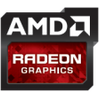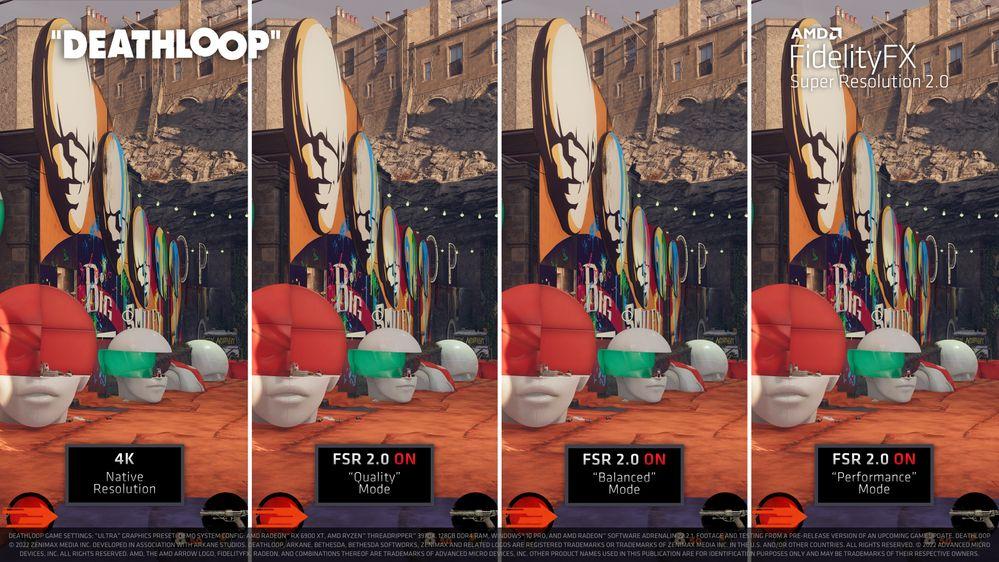AMD provided new data about AMD FidelityFX Super Resolution (FSR) 2.0, the company's widely accepted, open-source, cross-platform upscaling technology.
FidelityFX Super Resolution 2.0 is a temporal upscaling solution coming in Q2 2022, which delivers incredible image quality and boosts framerates in supported games by using previous frame data to provide similar or better than native image quality at all resolutions.
You can find more detail on AMD’s developer session in the following blog, while key details from today’s session include:
- High-Quality Upscaling without Machine Learning: While ML is one vehicle to solve problems, it is not a prerequisite to achieving good quality image upscaling. AMD engineers have developed and optimized a set of advanced, hand-coded algorithms to recognize and combine data from previous scenes, feeding into a high-fidelity, upscaled image in an easily optimized way that can cater to a range of different scenarios. Above all, not requiring dedicated ML hardware means that more platforms can benefit, and more gamers will be able to experience FSR 2.0.
- FSR 2.0 Quality Modes: FSR 2.0 will offer three primary quality modes available in all games supporting the technology, and one optional mode for developers to use. These include: “Quality,” “Balanced” and “Performance” modes, shown in today’s blog and updated screenshots. The fourth optional “Ultra Performance” mode is also available for developers who want to deliver the highest performance gain while still maintaining an image quality representative of native rendering.
- Hardware Support: Like FSR 1.0, FSR 2.0 maintains AMD’s open approach, supporting a broad spectrum of AMD and competitor hardware, however, as a temporal solution, FSR 2.0 is more demanding, which means more powerful, modern hardware may be required for higher upscaling resolutions. More information about this can be found in the blog.
- How FSR 2.0 is Integrated into Games: Just like FSR 1.0, FSR 2.0 will be open source via the MIT license and will be available for developers as an intuitive easy to use API that supports DirectX 12 and Vulkan. There will also be a plug-in for Unreal Engine.
- More Game Support and FSR 2.0 on Xbox: In addition to DEATHLOOP, Forspoken will also include support for FSR 2.0 when the game launches in October 2022. FSR 2.0 will also be fully supported on Xbox and will be available in the Xbox GDK for registered developers to use in their games.
High-Quality Upscaling without Machine Learning?
When we announced FSR 2.0 technology last week, we told you that it does not use Machine Learning (ML) in its upscaling algorithm and therefore doesn’t require any kind of dedicated ML hardware in supported products and platforms. But since then, we’ve seen that many of you have been asking for more details on how we are able to achieve the results FidelityFX Super Resolution 2.0 technology can deliver without ML.
Let’s add some context first -- in any science, which includes software engineering, discoveries are made by analyzing data from experimentation, resulting in mathematical models that can explain the results. These models can then be applied to new scenarios to make predictions. Broadly speaking, machine learning (ML) is an incredibly useful set of tools and techniques that can aid and accelerate this process. However, the results that ML achieves can sometimes not be the most optimal, lacking the spark of human imagination that can often lead to breakthroughs for complex problems.
Often, ML-based real-time temporal upscalers use the model learned solely to decide how to combine previous history samples to generate the upscaled image: there is typically no actual generation of new features from recognizing shapes or objects in the scene. AMD engineers leveraged their world-class expertise to research, develop, and optimize a set of advanced hand-coded algorithms that map such relationships from the source and its historical data to upscaled resolutions.
The FidelityFX Super Resolution 2.0 analytical approach can provide significant advantages compared to ML solutions, such as more control to cater to a range of different scenarios, and a better ability to optimize. Above all, not requiring dedicated ML hardware means that more platforms can benefit, and more gamers will be able to experience FSR 2.0.
FSR 2.0 Quality Modes
Like FSR 1.0, FSR 2.0 has different quality modes that allow you to customize the balance of image quality to performance to your preference. FSR 2.0 has three primary quality modes you can expect to find in all games supporting the technology, and one optional mode for developers to use if they desire.
We’ve adjusted the modes a little from FSR 1.0, with the highest quality setting now being “Quality” mode, which aligns with the modes available in other popular temporal upscaling technologies. The other two primary modes are “Balanced” and “Performance”, and you can see the details of each mode in the table below.
| FSR 2.0 Quality Mode |
Description | Scale factor | Input resolution |
Output resolution |
| Quality | “Quality” mode provides similar or better than native image quality with a projected significant performance gain. |
1.5x per dimension (2.25x area scale)(67% screen resolution) |
1280 x 720 1706 x 960 2293 x 960 2560 x 1440 |
1920 x 1080 2560 x 1440 3440 x 1440 3840 x 2160 |
| Balanced | “Balanced” mode offers an ideal compromise between image quality and projected performance gains. |
1.7x per dimension (2.89x area scale)(59% screen resolution) |
1129 x 635 1506 x 847 2024 x 847 2259 x 1270 |
1920 x 1080 2560 x 1440 3440 x 1440 3840 x 2160 |
| Performance |
“Performance” mode provides image quality similar to native image quality with a projected major performance gain. |
2.0x per dimension (4x area scale)(50% screen resolution) |
960 x 540 1280 x 720 1720 x 720 1920 x 1080 |
1920 x 1080 2560 x 1440 3440 x 1440 3840 x 2160 |
The fourth optional “Ultra Performance” mode is also available for developers who want to include a mode that is designed to offer the ultimate in performance gains while still maintaining an image quality representative of native rendering.
FSR 2.0 supports Dynamic Resolution Scaling too, where the input resolution to upscale from is determined (and dynamically adjusted) by the minimum framerate you want to always achieve in the game. Developers also have the option of applying RCAS sharpening to the output too.
As FSR 2.0 required the three data points in the diagram above at render resolution -- depth, motion vectors, and color -- developers will find it easier to integrate FSR 2.0 into games that already have a temporal upscaling rendering path. Keeping that in mind, although FSR 2.0 is still easy for developers to add to their game like FSR 1.0, integration time estimates can vary – it can be as little as a few days for games that already have the needed temporal upscaling data in place. However, for games without motion vectors or support for decoupled display and render resolutions, integration can take longer.
Just like FSR 1.0, FSR 2.0 will be open source via the MIT license and will be available for developers as an intuitive easy-to-use API (with the source provided via a library) that supports DirectX® 12 and Vulkan®, and there will also be a plug-in for Unreal® Engine.
Performance and Hardware Support
FidelityFX Super Resolution 2.0 is designed to boost framerates in supported games; however, it is fair to say that as FSR 2.0 is an advanced temporal upscaling solution, it will be more demanding on graphics cards than a spatial upscaling solution like FSR 1.0.
That does mean that while FSR 2.0 will support a broad spectrum of hardware, from both AMD and select hardware from our competitors, there are some caveats that gamers need to be aware of when compared to FSR 1.0. To start, though, we do want to say that as an open-source cross-platform solution, we are not placing any constraints on FidelityFX Super Resolution 2.0 compatibility, and what we are talking about here are recommendations for an optimal experience using the technology.
Noting the above then, for an optimal FSR 2.0 experience, we have some recommendations for the starting level of graphics card for the different target upscaled display resolutions. One thing to keep in mind, though, is that your gaming experience may vary with these hardware suggestions. Depending on your specific system specifications, the system requirements of individual games that support FSR 2.0, and your target resolution, you may be still able to have a good upscaling experience on lower-performing or older GPUs than listed below.
FidelityFX Super Resolution 2.0 Optimal Starting Level Hardware
| Target Upscaling Resolution | AMD Graphics Cards | NVIDIA® Graphics Cards |
| 4K |
Radeon™ RX 6700 XT |
GeForce RTX™ 3070 |
| 1440P |
Radeon™ RX 6600 |
GeForce RTX™ 3060 |
| 1080P |
Radeon™ RX 6500 XT |
GeForce® GTX 16 Series |
*Recommendations may change.



